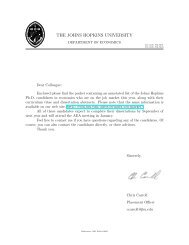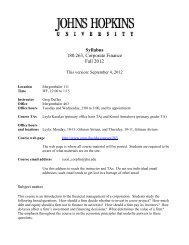WEALTH, DISPOSABLE INCOME AND CONSUMPTION - Economics
WEALTH, DISPOSABLE INCOME AND CONSUMPTION - Economics
WEALTH, DISPOSABLE INCOME AND CONSUMPTION - Economics
You also want an ePaper? Increase the reach of your titles
YUMPU automatically turns print PDFs into web optimized ePapers that Google loves.
First, there is little evidence that consumption is cointegrated with<br />
either total wealth or its human and non-human components – both the<br />
ADF test and the Phillips-Ouliaris (PO) test fail to reject the null of no<br />
cointegration at even a 10 per cent level.<br />
Second, the evidence that consumption is cointegrated with disposable<br />
income is mixed. The ADF tests fails to reject the null of no cointegration<br />
at a 10 per cent level, while the PO test rejects the same null at the 5 per<br />
cent level.<br />
Third, when disposable income and either total wealth or human<br />
and non-human wealth are included in the cointegrating vector, there is<br />
more convincing evidence of cointegration. Both the ADF and PO statistics<br />
reject the null of no cointegration at the 5 per cent level in all the long-run<br />
regressions that include wealth, and for the PO statistic this null is also<br />
rejected at the 1 per cent level. The one caveat is that the ADF statistics are<br />
somewhat sensitive to the number of lagged differences that are included<br />
in the ADF regression, but this problem should be minimized through use<br />
of the lag-length selection procedure advocated by Hall (1989).<br />
A fourth finding is that the relative price of consumption p plays a<br />
minor role in the cointegration results. The lower panel of Table 5 reports<br />
the results when p is omitted from the cointegrating vector, and the test statistics<br />
change very little. Overall, the results suggest that both disposable<br />
income and wealth are important long-run determinants of consumption,<br />
while the relative price of consumption is not. An examination of the<br />
cointegrating vector itself bolsters this conclusion.<br />
Table 6 reports the estimated long-run coefficients on disposable<br />
income, wealth and the relative price of consumption. The top panel of the<br />
table reports the Engle-Granger static ordinary least squares (OLS) estimates<br />
on which the Table 5 cointegration tests are based. These parameter<br />
estimates, while super-consistent (Engle and Granger 1987), are not efficient,<br />
and their distributions are unknown. To obtain more efficient estimates<br />
and perform valid inference on the long-run parameters, the<br />
cointegrating parameters are also estimated by means of the prewhitened<br />
27




